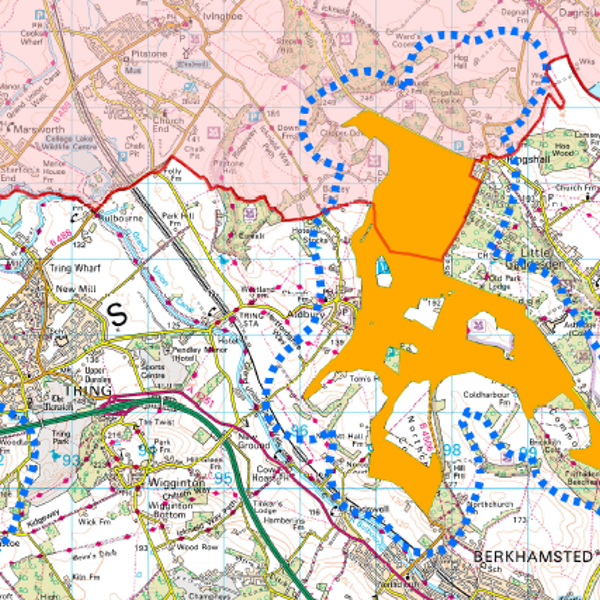What’s next for Nutrient Neutrality in Norfolk?
Six months since Natural England increased the list of habitat sites to include the Broads and the River Wensum, Amy Robinson, Senior Planner, reflects on the progress that has been made in identifying suitable mitigation strategies and allowing development for overnight accommodation to progress within the Nutrient Neutrality catchment areas.

What is the Nutrient Neutrality Problem?
As you are no doubt aware, on the 16 March 2022, Natural England issued advice to Local Planning Authorities, which effectively prevented planning applications being granted for overnight accommodation that have adverse effects on habitat sites, as a result of the impact of increased phosphorous and nitrates from wastewater generated by new development.
Latest figures show that more than 120,000 homes are now being delayed across 74 local authorities and within Norfolk alone it is estimated that approximately 10,000 homes are delayed. Next year, as a result of delays to the planning system, a 5% drop in housebuilding is forecasted, which will reduce supply of new residential accommodation, and further exacerbate the housing crisis.
Given the significant challenges facing the housing market and the wider economy; first time buyers are struggling to get on the ladder, energy costs are spiralling out of control, wages are stagnating, inflation has reached double digits, and a recession is around the corner – the development of new housing is clearly a pressing issue. The magnitude of this issue was recently highlighted by the new Prime Minister, and South West Norfolk MP, Liz Truss, who pledged to scrap Nutrient Neutrality requirements. However, it remains to be seen if there is a legal basis for this to be actioned.
What is being done to resolve this matter?
A number of actions have been progressed in the last 6 months, which are hopefully bringing us closer to unlocking the standstill in the planning system caused by the nutrient pollution. These are:
- The Nutrient Budget Calculator
-
- In March, Natural England prepared an overarching Nutrient Budget Calculator so that the level of mitigation required for developments to achieve Nutrient Neutrality can be calculated. However, one of the key limitations of this calculator is that it is too onerous and not tailored to local conditions.
- In response, Royal Haskoning, on behalf of the Norfolk Local Planning Authorities (LPAs), have prepared an updated Nutrient Budget Calculator, which is tailored to local conditions and potentially reduces the level of mitigation by 30-50% compared to the Natural England calculator.
- Royal Haskoning have also revised the catchment mapping to redefine surface water catchments based on more accurate topographical data, reviewed areas with any ambiguity, and added water recycling centre catchments to define waste water contributions. This will hopefully provide more certainty as to which sites are in the catchment area and where they are draining.
- The Royal Haskoning Nutrient Budget Calculator and updated catchment maps are expected to be published at the end of September 2022. However, the question remains as to whether Natural England will agree to the calculator and whether this will be adopted.
- In March, Natural England prepared an overarching Nutrient Budget Calculator so that the level of mitigation required for developments to achieve Nutrient Neutrality can be calculated. However, one of the key limitations of this calculator is that it is too onerous and not tailored to local conditions.
- Natural England Strategic Mitigation Scheme
-
- Recognising the uncertainty created by Nutrient Neutrality, on the 28 July 2022, the Government issued a Direction, which requires Natural England to prepare strategic Mitigation Schemes in all of the catchments where there are restrictions on development because of nutrient pollution.
- Natural England have confirmed that a newly funded Mitigation Scheme will be developed in partnership with the Government, which will create a nutrient mitigation habitat such as wetlands and woodlands that can be used as part of a credit scheme.
- As part of the process, it is intended that Natural England will issue nutrient certificates to developers who can use them for planning applications, which require mitigation to achieve Nutrient Neutrality.
- The Natural England’s Mitigation Scheme was expected to be in place in autumn, although, given the potential lack of resources and funding to deliver this, and the complexity of the issue, it is likely to be delayed.
- Recognising the uncertainty created by Nutrient Neutrality, on the 28 July 2022, the Government issued a Direction, which requires Natural England to prepare strategic Mitigation Schemes in all of the catchments where there are restrictions on development because of nutrient pollution.
- Norfolk LPAs Mitigation Scheme
-
- Norfolk LPAs are preparing their own Mitigation Strategy, in recognition that a portfolio of mitigations schemes are required to address such a large scale problem. This would also be a credit scheme, but the focus would be on ensuring this is not a ‘postcode lottery’. It is anticipated that one credit would cost between £5,000-10,000 per dwelling.
- It is intended that the credits will be secured via a Unilateral Undertaking for smaller sites and by S106 Agreement for larger sites. This will prevent smaller developers having to enter into costly and time-consuming legal agreements.
- There is, however, no definitive timetable for adopting this credit scheme, but it is likely that it will not be until 2023.
- It is also worth noting that Grampian conditions may be used to ensure that any mitigation is in place and functional prior to the occupation of any new dwellings. It is therefore one thing to have a strategic mitigation scheme identified, and another for it be implemented.
- Norfolk LPAs are preparing their own Mitigation Strategy, in recognition that a portfolio of mitigations schemes are required to address such a large scale problem. This would also be a credit scheme, but the focus would be on ensuring this is not a ‘postcode lottery’. It is anticipated that one credit would cost between £5,000-10,000 per dwelling.
- Upgrading existing Wastewater Treatment Works
-
- Recognising that the development sector is not the sole contributor to the problem, the Government has put pressure on water companies in England to upgrade wastewater treatment works in ‘Nutrient Neutrality’ areas in order to address nutrient pollutions in waterways by 2030.
- This assumes that the water companies have the resources and funding to implement these upgrades by 2030 and this is by no means certain.
- Recognising that the development sector is not the sole contributor to the problem, the Government has put pressure on water companies in England to upgrade wastewater treatment works in ‘Nutrient Neutrality’ areas in order to address nutrient pollutions in waterways by 2030.
What are the potential opportunities?
There are also potential opportunities emerging regarding 5-year housing land supply and sites located outside the Nutrient Neutrality catchment areas. This has been highlighted in the recent appeal decision at Land North of Heath Loke, Poringland. The Inspector allowed the appeal and outline planning permission was granted for up to 19 dwellings in light of South Norfolk Council acknowledging that they can no longer demonstrate a 5-year housing land and that the site it is outside the Nutrient Neutrality catchment area (i.e. the site can be delivered in the short term).
In summary, it is clear that progress has been made in the last 6 months, and there are some potential opportunities emerging for sites outside the catchment area within Local Authorities where a 5-year housing land supply cannot be demonstrated. However, significant questions remain as to what level of mitigation will be required, when and how the mitigation will be delivered, and what impact this will have on development viability and the preparation of Local Plans, notably the Greater Norwich Local Plan.
Get in touch
Related Articles

From Nutrient Neutrality to Ecological Moratoriums
In March this year, the Nutrient Neutrality announcement marked big news in the planning world effectively halting development in the Norfolk area. However, a different spanner has been in the works in Hertfordshire (and neighbouring shires) – the Chilterns Beechwoods Special Area of Conservation (SAC).

Norfolk’s Nutrient Problem
On 16th March 2022, Natural England increased the list of habitat sites that are considered to be in an unfavourable condition due to excessive nutrient levels. The extended list includes both the River Wensum and large parts of the Broads, and the ‘National Map of Catchments’ provided by Natural England suggests that a significant area of Norfolk will be affected by the change.
Stay in the loop
Sign up to receive personalised property alerts, and to hear the latest news, insight and advice from our experts
Keep me informed
